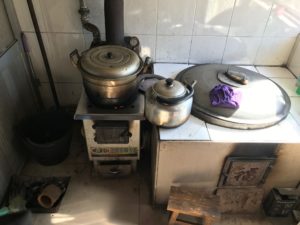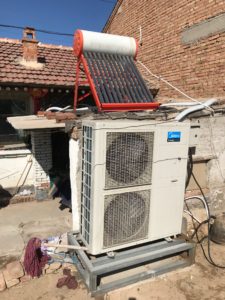If outside air is polluted, how much of that pollution circulates within the walls of our homes?
Ellison Carter, assistant professor in the Department of Civil and Environmental Engineering, is conducting a study to learn more about the impacts of air pollution from household use of solid fuels in rural regions of Beijing, China.

Many rural Beijing residents use solid fuels like wood and coal in their homes which, when burned, create air pollutants in the form of particulate matter. Chronic exposure to high levels of “PM 2.5,” or particles smaller than 2.5 microns in diameter, are linked to respiratory and cardiovascular problems, and even exposure at low levels can create adverse health effects.
Around the world, inefficient fuel sources like wood and coal contribute to higher levels of air pollution outdoors. In northern China, where annual average air pollution levels reach up to 20 times what’s recommended per World Health Organization guidelines, residential coal burning can account for nearly half of outdoor PM 2.5, exceeding the contribution of both the transportation and power sectors. In the midst of a large-scale household energy transition, policymakers in Beijing are trying to decrease air pollution throughout the province by steering residents toward more efficient and cleaner heat sources.
How much is enough?

What hasn’t been defined, however, is the scale of the transition needed to make a difference in overall air pollution. Converting one home is not enough to make a dent in the overall pollution level, but is converting a village enough? A district?
“We’re trying to understand how big the scale has to be to make an impact,” said Carter. “How many houses have to transition to cleaner household energy before pollution goes down?”
Carter and colleagues from McGill University are collecting information about household energy use, cost of energy, air quality and health to evaluate impacts of the household energy transition over the next several years. Through a pilot study conducted in 2017, the team determined that homes in villages that were not burning coal have lower indoor pollution levels than a counterpart village that was burning coal.
Powe Award
With the help of a Ralph E. Powe Junior Faculty Enhancement Award from Oak Ridge Associated Universities, Carter is factoring in the built environment to determine how it affects airflow between indoors and outdoors. Understanding how air is exchanged between inside a home and outdoors can help identify how pollutants get circulated.
“We want to understand the role of the residential built environment, especially when both indoor and outdoor sources can be dominant contributors to air pollution,” said Carter.

To further understand how the built environment interacts with airflow, Carter is recruiting help from colleagues at CSU and beyond. Modeling expertise from Jeffrey Pierce, associate professor in the Department of Atmospheric Science and CSU Monfort Professor, can help Carter see estimated long-term impacts of air pollution now, rather than waiting to observe real-time effects. Carter will be working with colleague Diana Hun at Oak Ridge National Laboratory, who facilitates tests on housing and residential wall assemblies in her lab. Together, they will use this opportunity to better understand air tightness, leakiness, and air change of rural Beijing homes.
“There’s a huge demand for better quality housing across the world, not just in Beijing,” said Carter. “I’m excited about the opportunity to work with these colleagues to understand housing interventions in a more systematic way.”
Carter heads back to Beijing in July with several of her collaborators to set up further air quality testing. Once testing and analysis are complete, she hopes publication of her research encourages policymakers pursuing housing and energy transitions to consider economic and health impacts of household energy use.